Part 2 of a 3-part story about Isaac Van Amburgh the Lion King, the Richmond Hill estate in Greenwich Village, and New York’s Zoological Institute in the Bowery
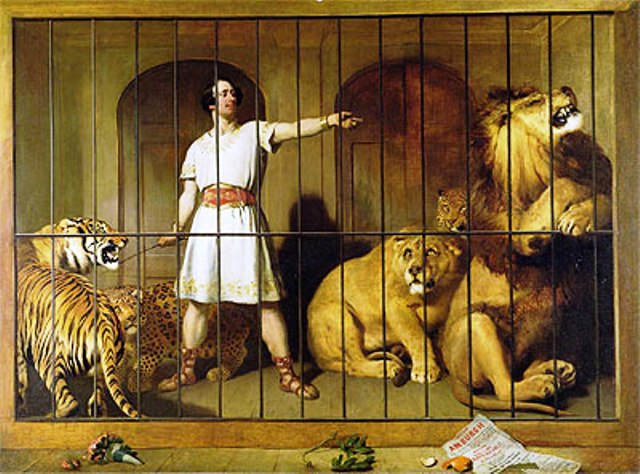
In 1833, Isaac Van Amburgh, aka the Lion King, made his New York animal training debut by stepping into a cage occupied by a lion, a tiger, a leopard, and a panther at the Richmond Hill Theatre.
In Part II of this old New York animal tale, I’ll tell you about the fate of the theater that once occupied the grand Richmond Hill mansion, and take a “then-and-now” look at the corner of Varick and Charlton streets in Greenwich Village, where the 26-acre estate once stood.
The Richmond Hill Estate of Greenwich Village

As I noted in Part I, the Richmond Hill mansion was built in 1767 by Abraham Mortier on land that he leased from the Trinity Church. The home of timber construction stood on a bluff overlooking the Hudson River, just west of today’s intersection of Charlton and Varick streets. It was reportedly painted yellow with a white portico supported by four large pillars.
The Richmond Hill estate has a fascinating history, which has been told many times (so I won’t get into details here). So I’ll fast forward to 1794, when Aaron Burr and his teenage daughter moved into the home (his first wife, Theodosia Bartow Prevost, had died that same year).
During Burr’s tenure at Richmond Hill, famous guests visited often and the dinner parties were lavish, to say the least. Unfortunately, Burr had difficulty supporting this lifestyle on his minuscule public-office salaries (it didn’t pay to be a senator or a vice president back then). Burr needed a plan to make more money.
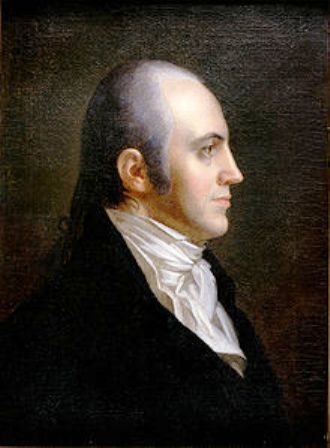
In 1797, as Manhattan’s residential development pushed northward, Burr tried to cash in on this opportunity by filing plans with the city to subdivide the estate’s grounds for “tract housing.” His plans called for the creation of three new streets running west from Macdougal Street to the Hudson River (Sixth Avenue did not yet exist): Burr; King (for Rufus King, a fellow U.S. senator); and Vandam (for Anthony Van Dam, a wealthy New York City alderman).
Although the city approved Burr’s plans, his debts prevented him from following through on them. In 1802, he allegedly tried to sell the estate for $150,000, but he received no offers. He eventually sold off some of the land and many of the home’s elaborate furnishings.
The final financial blow came in 1807, when Burr was put on trial for treason. Although he was acquitted, he could no longer hold onto the home. New York City rubbed even more salt into his wounds by expunging “Burr Street” from planning maps and renaming the proposed road Charlton Street in memory of Dr. John Charlton of the New York Medical Society, who had died months earlier.
In the end, Burr lost the Richmond Hill estate to creditors, who in turn sold the mansion and the lease on seven acres of land to John Jacob Astor for a pittance. Astor apparently tried to rent the home at first, according to an ad placed in the Mercantile Advertiser on April 8, 1812:
“The dwelling-house is in high and perfect order; the out-houses are numerous and convenient; the ground has a handsome forest, and affords pasture for a pair of horses and two cows. There is belonging to it an excellent kitchen garden, and the orchard has a variety of excellent fruit trees.”
I’m not sure if he got any takers on that offer, but I do know that by the 1820s Astor had begun to carry out Burr’s plans to develop the old Richmond Hill property.
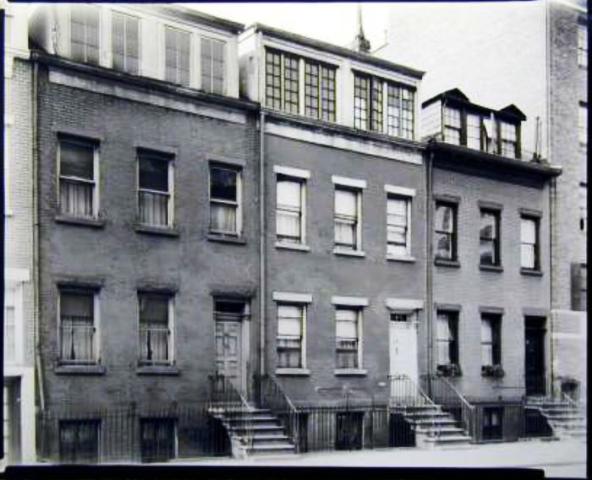
Richmond Hill Rolls Down the Hill
In December 1820, right around Christmastime, John Jacob Astor applied the first major insult to the old Richmond Hill estate by rolling the mansion downhill on logs to the present-day southeast corner of Varick and Charlton Street — about 100 feet east of Varick, to be exact. (At this time, Varick Street was just a narrow dirt road that ran through the property.)
According to reports, the home was removed a distance of 55 feet in 45 minutes, without the slightest damage to the house or fixtures (even the chimneys remained intact). Astor turned the mansion into a summer resort featuring a tavern with gardens, and began leveling the hill on which it had stood.
In 1822, Astor opened Charlton, King, and Vandam streets as part of his plans to develop the neighborhood. He sold the church leases on the lots to carpenters and masons, who built the Federal-style private homes that still make up much of the neighborhood today.

The Final Days of Richmond Hill
Astor’s summer resort was apparently unsuccessful, because by 1819 the old Richmond Hill mansion was reportedly occupied by a traveling circus featuring the popular clown Charles M’Donald. Then on November 13, 1831, Richard Russell opened a fashionable theater called the Richmond Hill Theatre on the site, which featured Italian operas and a variety of performances, including an equestrian company and the daring act of Isaac Van Amburgh the lion tamer. Miss Annette Hawley Nelson, a popular actress, managed the theater in the summer of 1836 and Mrs. Hamblin took over in 1837.
By 1840, the old mansion was called the Tivoli Gardens and Saloon. A newspaper ad that year stated that the gardens featured a promenade concert on Thursday, Friday, and Saturday evenings: “The whole garden is brilliantly illuminated with gas; an elegant band of music is engaged.” Admission was 12 1/2 cents, which included “any quantity of ice cream of superior quality”. Omnibuses ran directly to and from the gardens on a regular basis.
In 1843, the site reverted to a theater called Tom Flynn’s National Theatre. The structure was enlarged in 1846 and named the New Greenwich Theatre, and then in 1847, it was called the New York Opera House. The old mansion enjoyed temporary fame as a roadhouse and saloon before meeting its demise in 1849. Or should I say, before most of the structure met its demise…

For some reason, a portion of the old theater was preserved when the homes and stables pictured above were constructed in the 1850s. On December 11, 1913, remnants of the structure were uncovered by wreckers who were tearing down the buildings on the east side of Varick Street in order to widen the road. According to news reports, some painted fresco work that once made up part of the theater’s stage was uncovered on a beam in the rear of the stable. Those watching the demolition told reporters they could clearly make out the shape of the old stage.
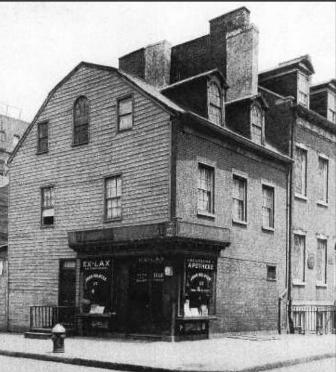
In 1893, George H. Brennan opened a café at 172 Varick Street, pictured here in 1911. This old frame and brick building on the northeast corner of Charlton and Varick was later called the Deutsche Apotheke, owned by German-born druggist John Hulster (John and his wife, Tillie, lived in the apartment upstairs). The building was torn down in 1914 when the street was widened (by this time, George had moved his cafe to the southwest corner of Charlton and Varick).
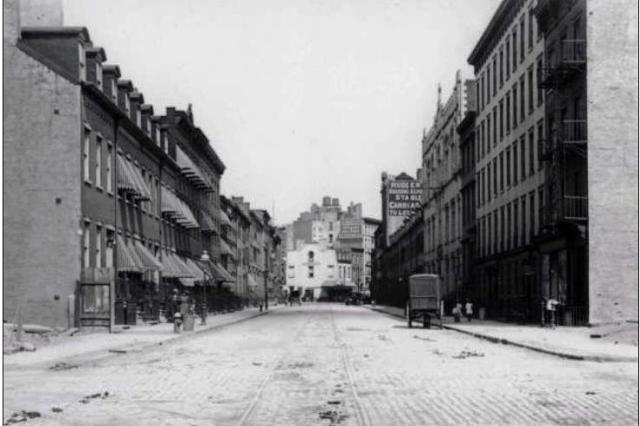
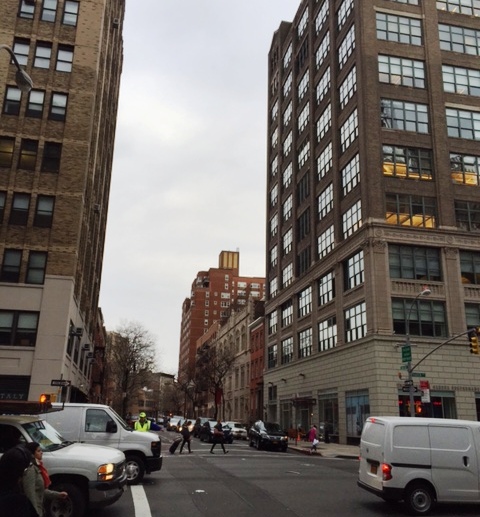
Here is the same view looking east down Charlton Street today. Although the trolley car tracks and horse manure are gone, a few of the older buildings are still standing, including the former Charlton Street Memorial Church at #40, now the Elizabeth Irwin High School (the light-colored three-story building in the middle of the photo) and the brick building to the right of the school.

This photo of Sixth Avenue at Charlton Street was taken in 1927 during construction of Sixth Avenue and the subway. Only months before, a townhouse at #7 Charlton had stood where the boys are standing in the left of this photo.
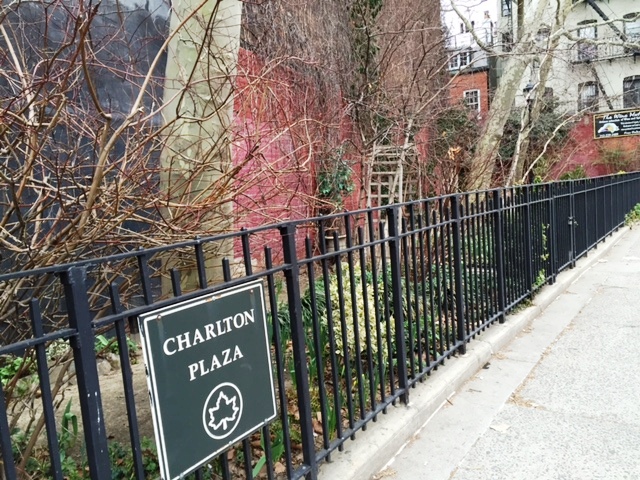
I took this photo of Charlton Plaza during my recent tour of the neighborhood. The plaza is located where the boys in the photo above were standing.
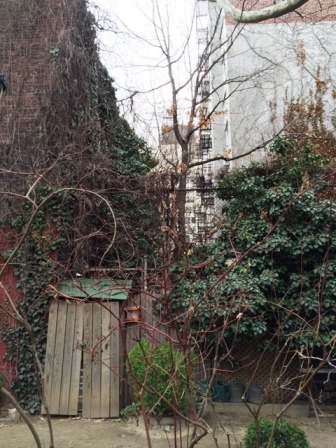
Although the old frame houses no longer exist, I did find this old wooden shed on Sixth Avenue and Charlton, which is right about where the grounds of the old Richmond Hill mansion were located after Astor rolled the house off the hill in 1820.
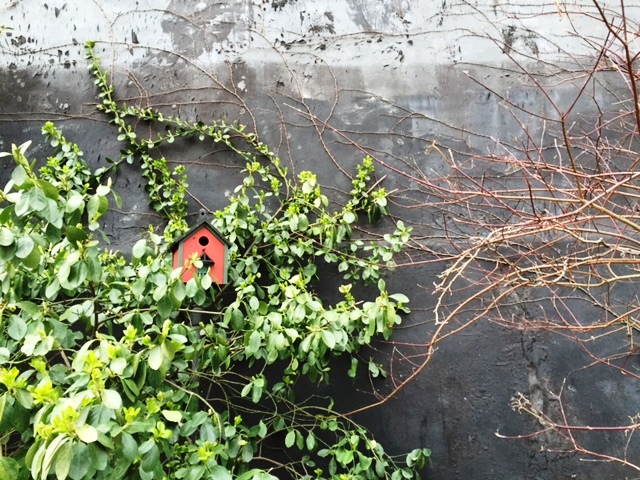
The deer and flying squirrels that were once in abundance in this part of Manhattan may be long gone, but the birds have found a nice home on Sixth Avenue and Charlton Street.
Stay tuned for Part III, in which I’ll tell you about the old theater and Zoological Institute on the Bowery, where Van Amburgh developed his career as a formidable lion tamer and circus man before meeting his own demise.



